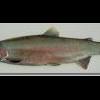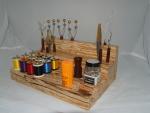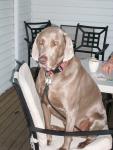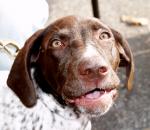-
Content Count
124 -
Joined
-
Last visited
Posts posted by Charlie Franklin
-
-
Thanks
This helps alot
Charlie
-
Hi All
Is Head Cement the Same as thin CA glue?
Thanks
Charlie
-
Thanks for all the kind remarks.
The base is awesome. It actually is made from spalted birch and it has a cork base to stop it from sliding( not a cover)
The pen is 60 dollars
My dad is actually a custom cabinet builder by trade and he is starting fly flishing line of furniture. ( he makes desks, bookcases,etc.)
Charlie
-
we look forward to hearing from you rocky.
I will see if has heard of that company
thanks
Charlie
ps
this is his website
www.pensbydaniel.com
-
these are his favorite thing to turn at the moment.
Charlie
-
-
Hey all
I have been looking around at all your fly tying desk,etc.
I thought I would show you what my Dad and younger brother made me for my addiction.
My Bro (13 Years old) turned me the dishes on a wood lathe (He has his own little business called pens by daniel) the dishes have rare earth magnets in them.
My dad made the tool caddy and vise pedastool out of spalted birch. He also made me the fly boxes.
He is working on a fly tying desk, with a spalted maple top
-
Right now I keep mine in the newest fishpond tying bag which was 100 bucks but it is pretty small so I have a few other boxes now. but they do make a larger one for 160 bucks.
But soon I am getting a desk so I will not need the bag unless I travel with it.
hope this will help
Charlie
fishpondusa.com
-
I got two packs of targus 1 x fine ( these are the ones I was talking about that are part of tiemco but filed in different place) But I hate them. Tiemcos 1 x fine dont bend this bad but targus hooks do.
Charlie
-
Charlie-One of the toughest thing beginning tyers have to do is figure out what materials to use with what patterns. In the meantime, the best advice would be to buy your stuff in a good local flyshop, or if you do the online thing, get stuff from places that specialize in fly fishing with an 800 number. Tell the folks what you’re tying, what you have already to see if that might work, and have them help you pick out the right stuff for what you need.
Stick to a few patterns at a time, buying just the stuff you need for them. The temptation is to go out and get one (or two) of everything. You’d be much better concentrating on one or two patterns at a time and knocking off a bunch of them. You’ll get better much faster at tying if you try and make each one a bit better than the last one.
You should also look into a beginners fly tying class—fly shops, groups like local chapters of Trout Unlimited often run them during the winter.
Just some info you might find helpful:
Neck and cape are generally used to describe the same thing.
Soft webby hackles vs stiff dry fly hackles- when you bend a feather stem you’ll see barbs that are stiff and point out straight (good dry fly hackle from specially bred birds (examples are Whiting Rooster capes or saddles with Red or Green Labels, The Green Label is Whiting’s Hebert Miner line) or barbs that clump together (web) and curve with the bend that are used in wet flies (hens and game birds like partridge, strung hackle, and Whiting American Rooster capes and saddles (Blue Label),
Dry Fly Saddles vs Capes Capes usually have a wider range of sizes (barb length) for different hook sizes usually 12-18 in the Bronze, Pro or Grade 3 categories, which is what I would start with instead of more expensive higher grades (longer feathers and run into smaller sizes in the 20’s). Saddles typically have longer feathers so you can get several flies from the same feather, but they typically are strongest in 2 sizes. Most Whitings for example have mostly 14-16 with some 12’s and 18’s. Other brands (and individual saddles) may be stronger in 12-14 or 10-12. They are easy to work with and are a good deal if you tie in a limited size range.
Here’s a link to Mike Hogue’s site. He has excellent articles that might help explain some of the differences (Understanding Feathers and Hackle and Understanding Soft Hackle Feathers) http://www.mwflytying.com/materials/materials.html
Good info on Hen feathers: http://globalflyfisher.com/staff/petti/garage/hen/
1. Steelhead flies- dyed strung saddle (6 bucks), or on the skin stuff like Whiting Blue Label “American” line hen cape (18 bucks), rooster cape (25 bucks) or saddle (13 bucks)
2. Small trout flies- for dry flies get a Pro, Bronze or Grade 3 Cape for a wide range of sizes flies down to 18 with some individual capes going to smaller sizes, For really smaller stuff, add a Whiting Bronze Midge ¼ Saddle (has sizes 18 and smaller and runs about 30 bucks) or Whiting 100’s in size 20 or 22 for about 15 bucks. But if you're new to tying start with size 12-16 first.
3. Artistic Salmon flies- very specialized, I’d save these for later
4. Larger Trout Flies- Dries cape or saddle. If you’re tying both large and small get a cape.
5. Any other situations- strung saddles for streamer wings and tails, mallard flank feathers for wings on dries, partridge for beards and tails on nymphs and collars on soft hackle wet flies, pheasant tail feathers for tail and body of Pheasant Tail Nymph.
If you’re just starting out and on a budget, and as you move on to different patterns, I would think about buying:
Strung saddle hackle black- for woolly buggers (an easy fly to tie and catches all kinds of stuff), and collars on steelhead flies like Green Butt Skunk. You can add bright color to steelhead flies by using different body material like bright colored yarn from around the house or a craft store (cheap), or packs of brightly colored marabou for wings on steelhead flies and tails on buggers.
A pack of loose partridge feathers for beards and tails on nymphs, and collars on wet flies like soft hackles. A pack will run about 3 bucks. It'll have less of a distribution of sizes than a full skin (which runs 25 or so), but is good to start with.
Good quality, but fairly inexpensive dry fly capes for about 30 bucks. I don’t have any experience with Keough, For a very good value and quality, I’d go with a Hebert Miner Pro Grade (owned by Whiting but a different genetic line from their Red Label products. The Hebert Miner line has a Green Label.), An alternative would be buying Whiting Bronze Grade ½ capes. You could also buy direct from a smaller grower, and speak to them directly. They’ll pick out what you need for whatever you’d like to tie. Grade 3 Conranch www.conranch.com or a Grade 3 Cape from Collins Hackle which includes a free saddle. Charlie Collins doesn’t have a web site but you can reach him at 607 734-1765. These all go for around 30 bucks, and will tie sizes from 12-18 at least. The owners provide a very good product, exceptional customer service and are a pleasure to deal with. By buying directly from them you are cutting out the middleman, so what you get for the dollar is a bargain. I would start with Grizzly and Brown, then add a medium dun and a cream or light ginger. Down the road, if you needed to tie really small stuff you could get a Whiting 100 pack in size 20 or 22 for about 15 bucks, but there will more than likely be some 20’s on these necks. You can also use some of the larger softer feathers at the base of these necks for buggers and wet fly collars.(both the HM Pro and Collins lines of birds are very strong in natural duns, gingers and unusual fishy shades like rusty dun in both beautiful solid and barring capes and saddles as well as dyed colors like Grizzly dyed Olive for green drake patterns). (I just ordered eight #3 Capes plus saddles from Collins for the first time and was so happy with them when they arrived i ordered four more.)
Hope this helps.
peregrines
Wow thats a lot of info.
I have been tying for 2 and a half years now and work with hackle alot.
you said something about strung hackle. but the strung hackle is always way to big. but I think I mentioned before that I found wapsi dyed rooster necks do you know anything about this?
Thanks for all your help.
Charlie
-
Thanks for all your guys help I will take a look at the sites you requested.
Thanks again
Charlie
-
Can you buy directly form wapsi?
Because there is other materials I want from them
Chalie
-
thanks I will try some of their hooks?
Do you know of any store in washington near seattle that carry them?
Thanks again
Charlie
-
I once came across spftware that was free and design for storing fly recipes but I could not download it because I have a mac it was only for windows so i do not know if it was any good so I can not recomend or rember its name
Charlie
-
I have a question to add on top of the curing.
How would you go about dying a bit of hair that you got from a fly store?
Charlie
-
I have found that I have a ton of hooks that I have baught to try out different types of hooks and I dont like them and I got some in a beginners tying pack which I also dont like. So really I dont like any of my hooks the only types I like are tiemco, mustad and orvis hooks. any have any good brand hooks.
I also purchased some the other day that are apparently made in the same factory and the same way as tiemco but filed in a different place, cheaper and are not called tiemco and the problem is that they bend when wrapping thread. they are 1x fine but even for 1x fine they seem too fine.
do you know of any store or online sites where I might be able to trade in hooks?
Any tips?
Thanks
Charlie
P.S
Also how do you organize your hooks.
do you do it buy brand, size, shape, how thick they are, hook bend, hook code or a mixture of some of these?
-
Thanks for the video
-
I see Day5 replied that he was just joking. I fall into the category of tyers that have way too much stuff, but just can't stop getting more. I have a room for tying that has an 18 foot counter with floor to seiling shelves. My materials collection fills 2/3 of the space, and a dresser as well. Yet most of this stuff is for tying fishing flies. I am still building a collection of materials so that I can get into classic and freestyle Salmon Flys, not to mention the classic wets and streamers. In 50 plus years of tying, I haven't tied 50 flys just for show, so I am still in the market for material. Its an addiction, but I can quit any time, if I have to, I guess. (Who said that?)I think he was just yanking your fly line. (Comment made while Day5 was responding.)
If your tying mostly small dry flies, 16 and smaller, then good dry fly necks are the way to go. You can purchase Keogh, Spencer, Metz Whiting, and a few others that have plenty of smaller hackles. You don't necessarily have to get the best grade. The top graded necks will have the least amount of web, longer feathers, more small sizes and be the best of the color lot. You would eventually want to get a red brown, a chocolate brown, a grizzly, a dun, a ginger and white in the best grade. Starting out, get a red brown, and a grizzly first grade neck. A second or the tyers grades will be less expensive. these are good buys in the fringe colors. I look for cree, and variant color necks when ever I am in a shop. I have some brownish dun necks, variagated gingers in several shades, and a couple of different shades of dun, and cream that I have picked up over the years. Currently counting 26 Dry fly necks.
In addition I have first quality saddles from Hoffman, and Metz that have very long, stiff, and glossy hackles. These are excellent for sizes 12, 14 and some are even able to tie a size 16. Most of these are for stimulators, and other attractor patterns for fast water. Three each in Grizzly, and brown and a couple of whites and one dun.
Second grade saddles are mostly for tying wooly buggers and other nymph patters. There are even bugger saddles with longer larger softer hackles. All togeather my soft saddle collection is 34 different saddles.
I use strung streamer and schlappen mostly for tying classic wet flies, and steelhead flies. I have strung saddles in yellow, kingfisher blue, white, red, orange, several shades of brown, olive, and grizzley or chinchilla. Most of these I picked up through the years at craft stores. I worked for a long time in a tackle store, and one of the local craft supplies started up a wholesale fly tying department. Since they were looking to expand, I got my mother into selling for them. She ended up with the full set of samples when the company went out of business (caused by events unrelated to material sales.)
I have a lifetime supply of neck and saddle capes, and a large assortment of strung saddle and schlappen, but I still pickup an occasional item if I see something just a lilttle different that I know I just have to have. When I moved the last couple of times, I gave away about half my material collection, and still I have a room full. I setup a neice and nephew with complete kits last summer, each with a jumbo tackle box of materials and sets of tools. You don't have to buy it all at once, but you can never have too much hackle no matter what form. Take your time, and pickup the hackle you need gradually, buy what works for your needs at the time.
I was in my local fly fishing store the other day and they had a couple of dyed rooster necks by wapsi for 15 dollars is that a good buy. but their dry fly necks are 25 dollars and up.
Charlie
-
ohhhhh!!!! LOL
-
WHy not one? I love the Idea of two but they are expensive!!!!!!!!!!!!
Charlie
-
I have a Weinrahmmer and a GSP. My weinrahmmer is 5 and loves to sniff my feathers. Unfortunatly he does not shed enough for me to use his fur as dubbing.
My GSP is 6 months and as soon as I blink or turn my head something is missing. the other day I dropped a feather I was about to use just as I tried to pick it up she swooped in and stole it. I tried to get it from her but she just looked at me and swallowed it!!!!!
 She might just shed enough for dubbing.
She might just shed enough for dubbing.This is Jackie My Weinrahammer
This is Molly My GSP We were in leavenworth, WA
-
Cool thanks
I will go get a neck and then in a few weeks a cape and saddle and see what one works best for me
Thanks
Charlie
-
the reason I ask is because I find that the strung rooster hackle packs are always so big for size 1/0 - 8.
thanks e. oregon midge
Charlie
-
What is the best materials to work with in the following situations? (Strung Rooster, Rooster Cape, neck or saddle)
1) tying salmon flies like the Comet, Skykomish Sunrise, ETC.
2) tying small trout flies
3) tying artistic salmon flies
4) tying larger trout flies
5) any other tying situations you can think of
I was just wondering what your takes are on this one.
Charlie










Project Healing Waters Challenge Swap # 2
in Fly Swaps & Contests
Posted · Report reply
Hi All,
I am not exactly sure if I am part of this swap because my name is not on the list and I know I signed up. I do have flies done but I am not queit sure if I am in.
Thanks
Charlie